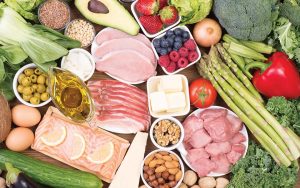Let’s not kid ourselves… When we were kids or even teenagers, most of us didn’t have to think twice about what we put into our bodies – that’s how efficient our bodies were back then as fat burning machines.
There may even be a handful among us who still eat that way without worries. How lucky can they be? The rest of us however, would have realised the shift in our respective metabolic rates as soon as we hit 30 years of age a slightly older. Probably, that’s when the topic of diet started to take over our lives. So, which kind of diet did it for you?

1. The Mediterranean Diet
The Mediterranean diet is based primarily on the eating habits of southern European countries, with an emphasis on plant foods, olive oil, fish, poultry, beans, and grains. The diet, known to be a healthy one as well as a cultural one, is also known to be low in trans fats, and free from refined oils and highly processed meats and foods. It has been a way of life for the people of Crete, Greece, Spain, southern France, Portugal, and Italy to eat this way, and many of them live long and fruitful lives, probably owing to this nutritious diet.
Adapting to the Mediterranean Diet isn’t very difficult to do here in Malaysia, for all of the foods as well as meal ingredients are easily available at supermarkets and grocery stores. The only fact to look out for is the quality of the food and ingredients you pick to include in your diet.
The Mediterranean diet consists of:
- Lots of vegetables, such as tomatoes, kale, broccoli, spinach, carrots, cucumbers, and onions
- Whole grains such as whole wheat, oats, barley, buckwheat, corn, and brown rice
- Legumes, beans, nuts, and seeds, such as almonds, walnuts, sunflower seeds, and cashews
- Cheese and yogurt as the main dairy foods, including Greek yogurt
- Some fish and poultry and oysters
- Fresh fruit such as apples, bananas, figs, dates, grapes, and melons.
- Olive oil as the main source of dietary fat, alongside olives, avocados, and avocado oil
- Eggs
The Mediterranean diet does not include much red meats and processed desserts. One glass of wine a day may be taken by some people, but water remains the main drink.
2. The Keto Diet
The ketogenic diet has been gaining fame among the health conscious for the past decade or so. The diet was said to have been created during the early 1920s by one Doctor Russel Wilder, who originally used it as a treatment for epilepsy. It was based on the idea of a fat-centric diet that mimicked the effects of fasting by depleting the body of sugar.
It’s one of the top diets in the world today. Basically, you limit your carbohydrate intake to the very minimal – less than 50 grams a day. Let it be known here that thousands of Malaysians go way past that at breakfast itself – a typical serving of nasi lemak has approximately 80 grams of carbs! Most fruits are a no-no, and vegetable intake is capped too. You will however be upping fat intake. It sounds contrary to common sense, but it allows the body to burn fat as a fuel, rather than carbohydrates. So, healthy fats, such as those in avocados, coconuts, Brazil nuts, seeds, oily fish, and olive oil are liberally added to the diet to maintain an overall emphasis on fat.
Typically, your body is fueled by glucose in the form of carbs, which can be found in flour, grains, vegetables, legumes, dairy products, and fruits. We usually introduce a steady stream of glucose into our bodies with each meal or snack. When you remove carbs from your diet, your body turns to fat as an energy source instead. In this process, fat travels to the liver and is used to make ketones, an acid. These are released into the bloodstream, which your body converts into energy.
A classic keto diet consists of 90 percent of calories from fat, six percent from protein, and four percent from carbs. In short, it radically goes against our classic food pyramid in every way. The idea is that burning fat instead of glucose will lead to quicker and more effective weight loss

3. Weight Watchers
Founded in 1963 by an American housewife Jean Nidetch, the Weight Watchers is a diet program with millions of members to date in over 30 different countries around the world.
Nidetch and a group of friends in her neighbourhood initially started meeting once a week to plan their diets and discuss how to lose weight. In time, they gave themselves a name – the Weight Watchers.
Today, Weight Watchers is an international company and the largest commercial weight loss program in the United States (U.S.). Approved by many physicians, it is available in various settings, from the local community to the workplace and online. Members attend regular meetings, where they learn about nutrition and exercise, as well as having their weight loss progress monitored via a points system. The dieter aims for a target weight or a body mass index (BMI) of between 20 and 25, which is universally considered the ideal range.
4. The Raw Food Diet
This diet consists mainly of foods that can be eaten raw – such as leafy greens, nuts, seeds, beans, fruits and juices. Typically, around ¾ of the person’s diet will consist of raw, uncooked food. The raw food diet can be divided into three main categories:
Raw vegetarians eat plant-based foods plus eggs and dairy products
Raw vegans eat no animal products at all, which means no dairy or eggs
Raw omnivores eat plant-based, meat and animal-based foods
The raw food diet may turn out to be an effective way to stay at the top of one’s health, provided you get ample amounts of essential nutrients such as vitamins, proteins, minerals and essential fatty acids from the foods you eat. The following foods are suitable for the raw food diet:
- Fresh fruits and raw vegetables
- Freshly made fruit and vegetable juices
- Milk from a young coconut (santan)
- Soaked and sprouted beans, grains, and legumes
- Dried fruits
- Raw nut butters
- Nut milks
- Raw nuts and seeds
- Seaweed
- Sun-dried fruits
- Fermented foods, such as kimchi and sauerkraut
- Green food powder, for example, dried wheatgrass or algae
- Other organic, natural, or unprocessed foods
- Purified water, but not tap water


